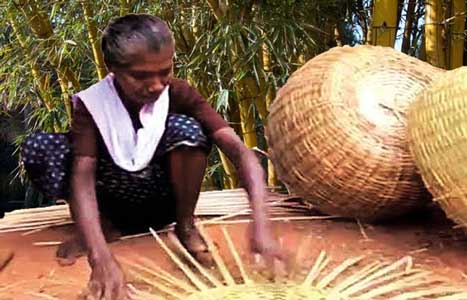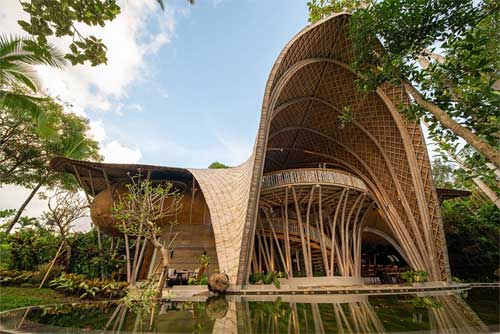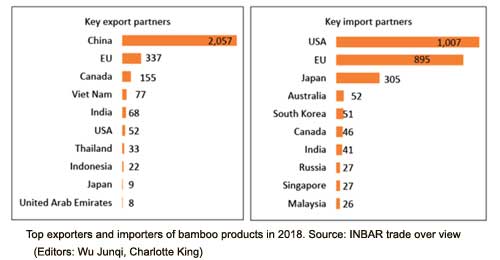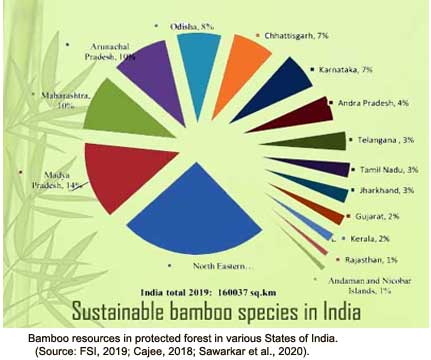Why Bamboo?

Bamboo is evergreen and strong woody grass belonging to the Poaceae family. Bamboo is the world's fastest-growing plant; it is a sturdy and long-lasting material that has been utilised structurally for thousands of years in various regions of the world.
Bamboo species are utilised for various purposes depending on their properties. Bamboo has versatile uses as a building material, paper pulp resource, scaffolding, food, agriculture implements, fishing tools, weaving material and a substitute for rattan, plywood and particleboard industries. Bamboo based products are one of the oldest traditional cottage industries in India. Bamboo can provide environmental, economic and livelihood security to the people.
Environmental Benefits of Bamboo

Bamboo cultivation in large quantities can assist in the absorption of greenhouse gases from the environment. It also absorbs carbon dioxide and releases roughly 35% more oxygen than hardwood trees. Bamboo stores substantial carbon in below-ground parts, i.e., rhizomes and roots and would contribute to enriching carbon pool at lower depths, even up to one metre and beyond. As well as, these strong roots in the ground make the soil more stable. This means it can stabilise, restore the land, and prevent landslides. Bamboo devours high amounts of nitrogen and this helps decrease water pollution. Because of bamboo's rapid growth rate and regeneration abilities, it is one of the most renewable resources on the planet. Hence scientific bamboo plantations would also be important for mitigating measures against climate change. For more information on the environmental benefits of bamboo, read the page "Ecological services by Bamboo."
Future of Bamboo

Bamboo is being celebrated globally as the building material of the feature because of its excellent structural properties, sure and sustainable availability and its minimum ecological impact.
Modern technologies allow the use of bamboo as a durable and high-quality wood substitute. Bamboo bridges and prefabricated houses have enormous possibilities in defence, disaster management, and low-cost housing. Premium products such as bamboo flooring, laminated furniture, mat boards, strand lumber, Pack-flat and knockdown furniture and so on have enormous international demand, with significant financial and employment benefits for the poor. Hence there will be a concentrated effort to merge traditional and innovative approaches with technological infusion to produce value-added products that meet global standards.
Increased bamboo-based livelihood industries reduce dependency on trees, resulting in less deforestation and conflicts between wild animals and humans.
Bamboo in the Indian Economy

The demand for bamboo-based products is increasing day by day, especially for pulp and paper, plywood, and flooring etc., Bamboo products are also good substitutes for wood products and there is a great demand for engineered bamboo products including laminated bamboo, reconstituted densified bamboo, and bamboo boards.
According to INBAR 2019 report, the international trade value of bamboo was 68.8 billion USD in 2018 which impacted 2.5 billion people directly or indirectly worldwide.
In 2018, China accounted for 67 per cent of the world’s export of bamboo products with total export value was 2.2 billion USD, and an import value was only 31 million USD. The forest is a major source of bamboo resources in China and it is estimated with around 6.67 million hectares of bamboos, with an annual bamboo production of around 40 million tons.

FSI, 2021 estimates shows that India has more bamboo resources (15 million ha) with Madhya Pradesh having a maximum bamboo bearing area (1.84m ha) followed by Arunachal Pradesh (1.57 m ha), Maharashtra (1.35m ha), and Odisha (1.12m ha).
According to National Bamboo Mission, the annual production of bamboo in India is 14.6 million tonnes only and the annual yield varies from 1 to 3 tonnes per ha, a major issue to be addressed. India is exporting bamboo & bamboo products to over 154 countries.
During the year 2020-2021 (April-November), India exported bamboo worth USD 140.47 million and imported USD 107.0 million. Hence, despite the growing stock both within and outside forests, India is a net importer of bamboo. It signifies that there are more opportunities to capitalise on market potential by increasing production and establishing the right value chain environment.
Bamboo has tremendous untapped potential for transforming India’s rural economy. About 8.6 million people depend on bamboo for their livelihood. Bamboo can serve as a means to achieve the UN-framed Sustainable Development Goals (SDGs) and is the best solution to environmental degradation and sustainable development in India
